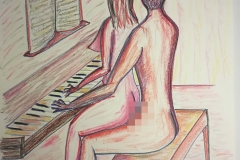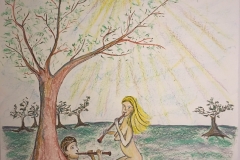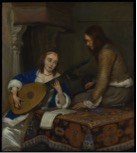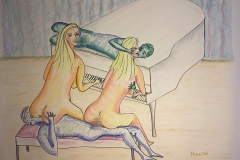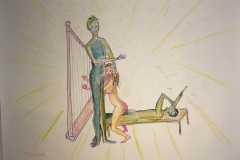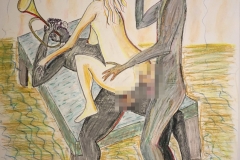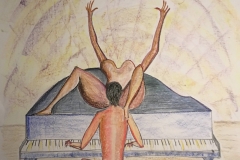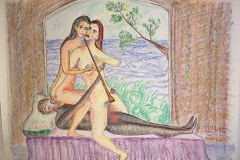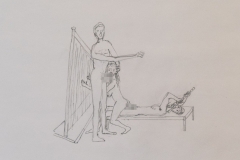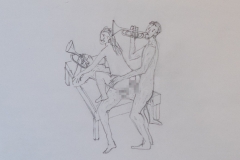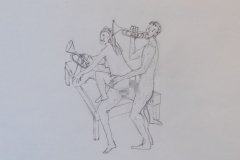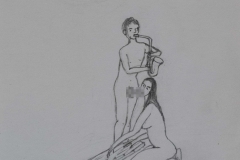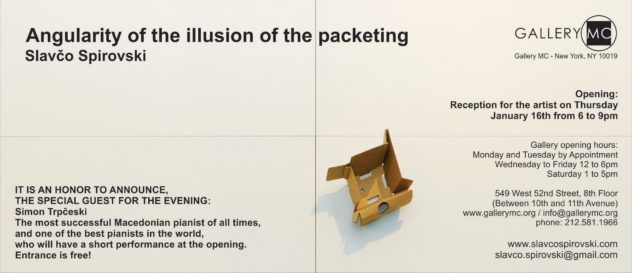Milos Raickovich, Players: Erotic Paintings and Drawings
Gallery MC, New York, January 29- February 1st, 2020
Gallery Hours: Wednesday – 10 am – 3 pm; Thursday and Friday, 12 noon – 6 pm, Saturday 2 pm to 7 pm
In his exhibition Players, the composer Milos Raickovich joins the ranks of visual artists with his ribald scenes of musicians “making merry.” In over 30 works drawn in oil pastel and pencil, Raickovich lets us peek into practice rooms, private dwellings and pastoral settings where the joy of sex is performed in duets, trios, quartets, etc.
Best known as a composer of powerful symphonic music and dreamy Romances, written in his own style – New Classicism, Milos Raickovich, who was born in Serbia, lived in Belgrade, Paris, Honolulu, Hiroshima and New York. He currently lives in Brooklyn and has found—besides composing, conducting and concertizing—yet another passion through which he can channel his prodigious creativity. Raickovich explains:
I loved visual arts since my childhood. I was always drawing. Sometime in my teen years, I discovered music, and I switched my passion completely from visual creations to composing. I didn’t do any visual arts again, until recently, at age 62, when in January 2019 I made a pencil drawing, Au Piano (At the Piano) – of two women playing piano 4-hands, and making love with two men at the same time. The combination of classical-music performers in erotic positions became an obsession, and soon I came up with other drawings. Some of them are connected to particular music pieces (Mozart’s “The Magic Flute,” or Thomas Morley’s madrigal “Now is the Month of Maying”), while some of them are just a play on chamber-music making.
***
PLAYERS: Erotic Paintings and Drawings will be on view January 29-February 1st, 2020. The reception on Friday, January 31, from 6-8 pm, features a short concert (at 7 pm) of Milos Raickovich’s music performed by soprano Rebecca L. Hargrove, pianist Danijela Popović, and the composer.
This exhibition and opening reception are free and open to the public – adult discretion is advised.
Milos Raickovich, La Leçon (The Lesson), 2019, oil pastel
Milos Raickovich, Players: Erotic Paintings and Drawings
Exhibition Essay by Beth S. Gersh-Nešić, director of the New York Arts Exchange
If music be the food of love, play on,
–William Shakespeare, Twelfth Night, Act I, scene I, spoken by the lovesick Duke Orsino
Sex and music go together like mac ‘n cheese, peanut butter and jelly, champagne and caviar. A delicious duo, they enhance each other in ways words cannot express. Visual artists know this well. Therefore, their spicy images have belonged to art history since antiquity through today’s YouTube videos. In his exhibition Players, the composer Milos Raickovich joins their ranks with his ribald scenes of musicians “making merry.” In over 30 works drawn in oil pastel and pencil, Raickovich lets us peek into practice rooms, private dwellings and pastoral settings where the joy of sex is performed in duets, trios, quartets, etc.
Milos Raickovich, Pastorale, 2019, oil pastel
Best known as a composer of powerful classical symphonies and dreamy Romances, written in his own style—New Classicism, Milos Raickovich, who was born in Serbia, trained in Belgrade, Paris, Los Angeles, Honolulu, Hiroshima and New York. He currently lives in Brooklyn and has found—besides composing, conducting, and concertizing—yet another passion through which he can channel his prodigious creativity. Raickovich explains:
I loved visual arts since my childhood. I was always drawing. Sometime in my teen years, I discovered music, and I switched my passion completely from visual creations to composing. I didn’t do any visual arts again, until recently, at age 62, when in January 2019 I made a pencil drawing, Au Piano (At the Piano) – of two women playing piano 4-hands, and making love with two men at the same time. The combination of classical-music performers in erotic positions became an obsession, and soon I came up with other drawings. Some of them are connected to particular music pieces (Mozart’s “The Magic Flute,” or Thomas Morley’s madrigal “Now is the Month of Maying”), while some of them are just a play on chamber-music making.
Ancient Greek, Odysseus and Calypso, c. 500 BC, red figure, kylix,
Musée du Louvre, Paris
Making music to symbolize making love certainly goes back to ancient Greek art, where we see men and women playing flutes and lyres to entertain as well as arouse. In the circular bottom of a kylix (a wine cup), the nymph Calypso enchants Odysseus by playing her songs and offering unlimited kindnesses to keep him imprisoned on her island. Depictions of sensual pleasures beneath the last drop indicate that with imbibing comes similar enjoyment.
Gerard ter Borch, Woman Playing a Theorbo-Lute and a Cavalier, c. 1648
Metropolitan Museum, New York
In 17th century Dutch art, we often find men or women playing musical instruments to suggest the mood of amorous encounters. In Woman Playing a Theorbo-Lute and a Cavalier, Gerard ter Borch places a watch on the sumptuously covered table, signaling that their dalliance will be brief, like the life itself—a typical theme for this culture.
Raickovich’s delightfully frisky drawings have none of these moralizing overtones. His players fool around harmoniously, enjoying each other con brio.

